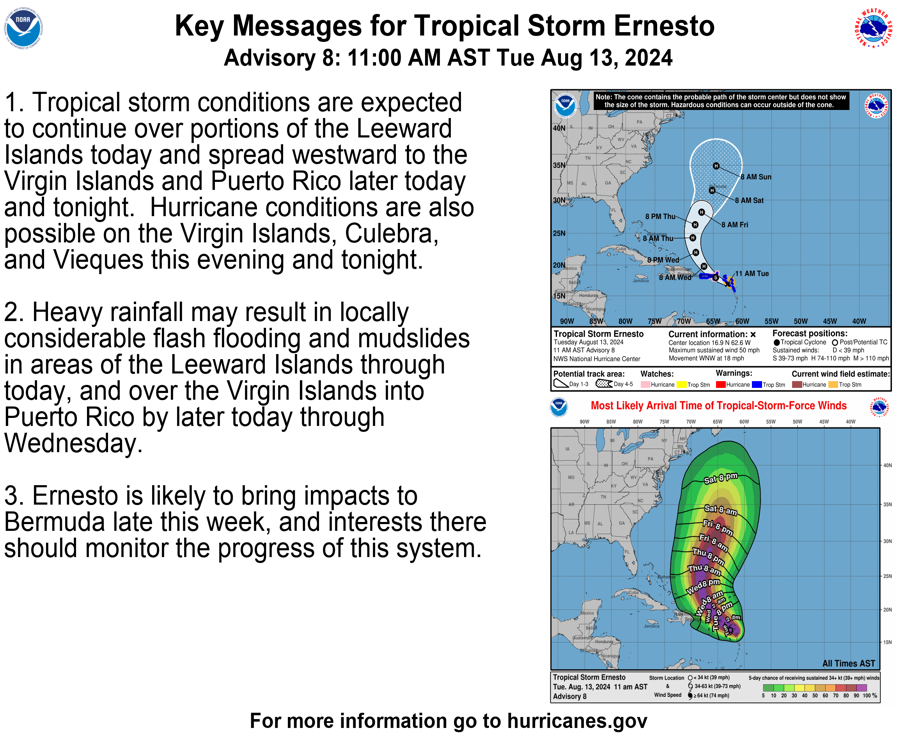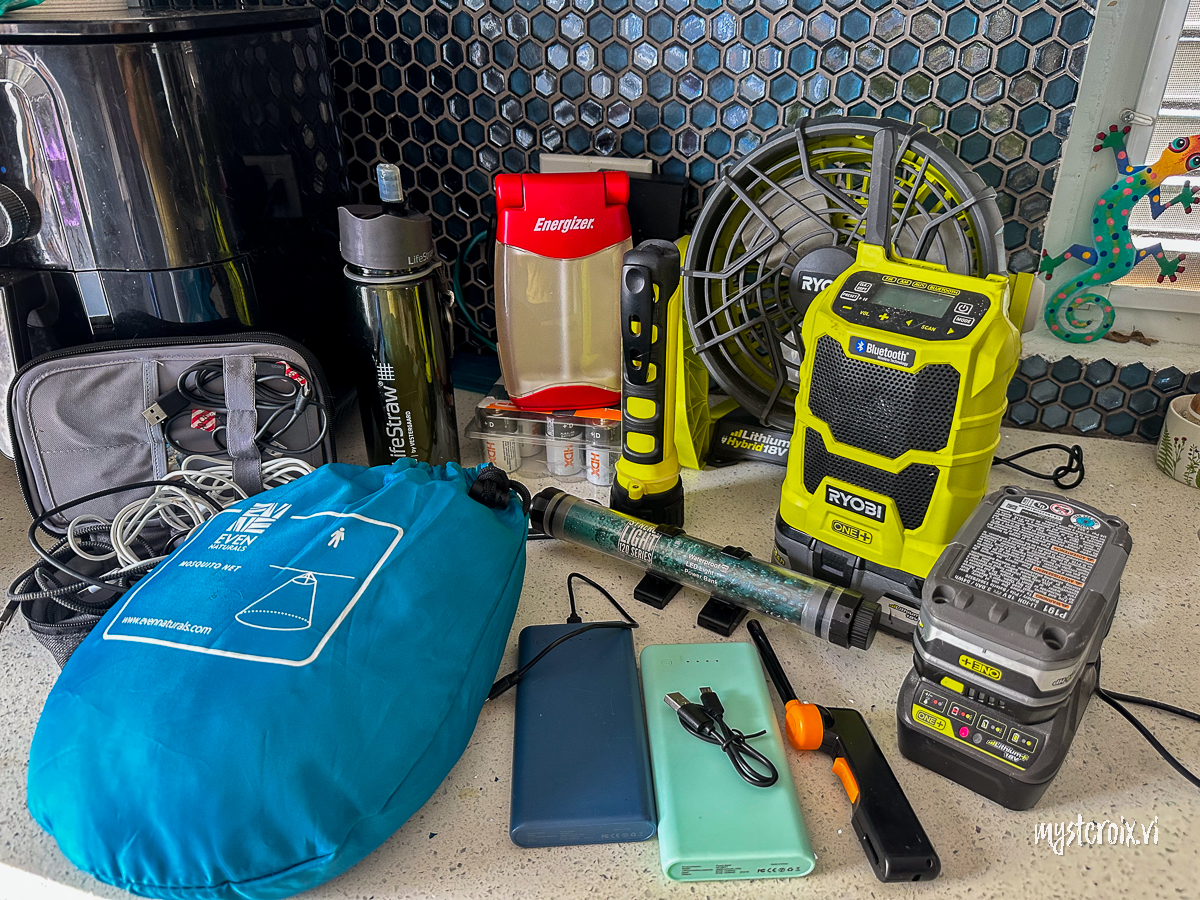Living through two Category 5 hurricanes—Irma and Maria—in the US Virgin Islands was a life-changing experience. The 2017 devastation was unimaginable, and the aftermath was challenging. We had curfews that lasted through Thanksgiving (no cars on the road after dark). My neighborhood didn’t have power for over four months. But these experiences taught me valuable lessons in hurricane preparedness and living through the aftermath of a natural disaster that I want to share with you.
Whether you’re new to the islands or preparing for the next hurricane season, these tips and recommended items will help you be ready for whatever comes your way. In fact, they can be helpful for any type of natural disaster no matter where you live.
CHRISTIANSTED WEATHERStay Informed:
As an islander since 2001, when Hurricane Season starts (June 1 – November 1) I pay more attention to the weather reports. I look fairly regularly at the satellite in the Southern Atlantic region. I watch for disturbances coming off the west Coast of Africa and keep an eye on them as they track across the Atlantic. If they are compressed and somewhat circular, I start to check the NOAA Hurricane Center daily.

If something pops up that they are tracking, I pay attention to the daily Tropical Weather discussion for some insight. I’ve become a bit of a weather nut and am an admitted science nerd. But, I know that sometimes you just want it quickly put in simple terms. Here are some of the places that I check for interpretations of the upcoming weather:
- Wunderground.com (I have the app on my phone and check it daily year-round. I find it to have the most accurate weather for St Croix)
- Windy.com (App available) – I use the app when a storm is West of us. I use the predictor to scrub ahead a few days to see the wind predictions in a colored format. I have found them to be pretty accurate and it gives .
- MyRadar App – this gives pretty accurate notices ahead of rain and other storm-related warnings.
- As storms approach the Lesser Antilles, I also follow a couple well-done Facebook pages by VI Weather Lady and US Virgin Islands Tropical Hurricane Weather Station. Both are run by knowledgeable weather experts right here in the USVI. The Tropical Hurricane Weather Station is run by a Hurricane Hunter and forecaster who lives here on St Croix. I value their insight and look to them for what mode of Hurricane Preparedness I need to be in.
- And, of course, I follow the NOAA Hurricane Hunters. As things get active in the Tropical Atlantic, they base their operation right here on St Croix. These brave folks literally fly into the eye of the storm to bring us accurate data to help us prepare. If you see them out in their flight suits, THANK them!!
I also highly recommend listening to local island elders and sailors. They watch the seasonal weather patterns and I’ve seen some predictions bear true over the past 23 years living on St Croix. A salty old Captain from Antigua that I sailed with told me to always watch to see if a storm strikes Martinique. “If it hits Martinique, it’s going to hit St Croix.” I’ve found that to be the case often. I trust the experience of generational Caribbean islanders and watch to see how much they are preparing ahead of a storm. If I’m in the grocery store and they tell me to grab provisions to prepare, I do!
viNGN has an excellent online resource guide with US Virgin Islands radio stations and Government agencies that can be helpful pre-, during, and post-storm. Click here for viNGN Disaster Preparedness Guide
Know the Basic Storm Terminology:
- Tropical Depression —A tropical cyclone with maximum sustained winds of 38 mph (33 knots or less.
- Tropical Storm — A tropical cyclone with maximum sustained winds of 39 to 73 mph (34 to 63 knots).
- Hurricane —A tropical cyclone with maximum sustained winds of 74 mph (64 knots) or higher.
- Major Hurricane —A tropical cyclone with maximum sustained winds of 111 mph (96 knots) or higher, corresponding to a Category 3, 4 or 5 on the Saffir-Simpson Hurricane Wind Scale.
- Watch —A Hurricane or Tropical Storm watch is issued 48 hours in advance of the anticipated onset of tropical-storm-force winds.
- Warning —An announcement that storm conditions are expected somewhere within the specified area within 36 hours. (Tropical Storm: sustained winds of 39 to 73 mph; Hurricane sustained winds of 74 mph or higher)
Source: NOAA Tropical Cyclones Preparedness Guide (full of helpful information!)
Hurricane Preparedness Essential Items for Survival & The Aftermath:
I may have flunked out of the Brownies/Girl Scouts, but I still live by the adage “an ounce of prevention is worth a pound of cure.” And by Murphy’s Law. If you follow good hurricane preparedness and check things off your list in advance, you’ll be a-ok. (fingers-crossed, knock wood)

- Flashlights and Battery-Operated Lanterns: Power outages are inevitable during and after a hurricane. Having reliable light sources like flashlights and battery-operated lanterns is crucial. I also had a few great Luci solar lanterns that I used for months. They blow up and were easy to hang outside during the day to charge and they lasted for a couple of years.
- Synergy 120 Light: The Synergy 120 Light is a versatile and powerful lighting solution. Its USB rechargeable battery makes it exceptionally handy for long-term power outages. I have the magnet attachment to keep it on the side of my refrigerator and it lights up my kitchen and living room whenever there’s a power outage. (which IYKYK happens a LOT on St Croix)
- Lifestraw Bottle Filters and Water Purification Kits: Access to clean drinking water is essential. Lifestraw Bottle filters, Filter Pitchers, and water purification kits can make contaminated water safe to drink. A literal lifesaver when water supplies are compromised from salt spray and debris. With so many in the Caribbean relying on cisterns for water, this can be a game changer. I can tell you from personal experience assisting with rescue efforts post Irma and Maria, shipping bottled water is expensive and a logistical nightmare. Having the ability to filter your drinking water safely at home – priceless!

- Ryobi Bluetooth Radio: Staying informed during a storm is vital. The Ryobi Bluetooth radio lets you tune in to local stations for updates. This can be critical in the event of evacuations and in the aftermath for getting information about power, supplies, potential curfews, and more. My Ryobi batteries power both my radio and fan so that I have a backup if needed. I make sure they are powered up (there’s a convenient button to press to check) before every storm.
- Ryobi Battery-Operated Fan: The Caribbean heat can be unbearable, especially without electricity. A battery-operated fan can make a huge difference in comfort. Having a fan with a rechargeable battery is key.
- A Headlamp: They’re not just for camping! I found my headlamp to be invaluable during the 4 1/2 months my neighborhood went without power. We ran a generator for a few hours a day, but when that was out it was DARK without any ambient light from the neighborhood houses or street lamps. Popping on a headlamp allowed me to get things done, cook, take a trip to the bathroom, etc while keeping my hands free. (be sure you have a stock of batteries)
- Mosquito Net & Bug Spray: As unbearable as the heat can be, the mosquitoes can be even more so. Having a mosquito net to sleep under will keep you and your family protected from not only the annoying little buggers but also the nasty illnesses that they can carry like dengue and zika.
- USB Power Banks: Keeping your devices charged is essential for communication and accessing information. I have two Portable Power Banks with two USB ports each that ensure my phone and other electronics stay powered. They power a LOT. Bonus: they are also part of my travel kit and comply with International Aviation Standards for carry-on devices. Just make sure, in advance, that you have the correct adaptors for your devices to connect to USB ports.
- Gas or Solar-Powered Generators: Generators are a must for long-term power outages. Whether gas or solar-powered, they can keep your essentials running and provide much-needed relief. And living on an island with lots of sun the majority of the time, I’m a fan of the solar-powered options.
- Use a Well-Insulated Cooler for Accessible Items: Keep a well-sealed, insulated cooler for items you need to access more frequently. This allows you to keep your freezer closed as long as possible, extending its cooling effect.
- Refillable Long Lighter and Extra Butane: A refillable long lighter and an extra can of butane are perfect for lighting candles, a gas stove, or a grill. They’re small but crucial items to have on hand.
- A Good First Aid Kit: A comprehensive first aid kit with plenty of antibacterial wash and ointments along with bandaids and bandages is vital. After Irma and Maria, we experienced a shortage of tetanus shots, and the cleanup efforts post-storm can be hazardous. Getting nicked or stepping on rusty nails from loose debris piles is a real threat. Be sure to get up-to-date on your tetanus shots before storm season if possible.
Personal Tips for Hurricane Preparedness:
Typically, I don’t stress a lot over tropical storms and Category 1 or even Category 2 Hurricanes. I know that we will likely have some extended power outages but the damage and aftermath should be minimal. That being said, conditions can be drastically different from one area of the island to the next. So, if you are new to the Caribbean and island life, check with your neighbors who have more experience. See when they put up storm shutters and take more serious steps in their storm preparation.
For me, if the forecast is for a Tropical Storm or a Cat 1 or 2 – I prep for a few days of having no power and I make sure that my outdoor patio is cleaned up. I take down my patio umbrella and bring in smaller plants (after they’ve gotten a nice soaking from the first bands). For a TS, I also spray down my patio furniture with a natural cleaner. I know it’s going to get a nice washing outside. For a Hurricane, I bring in any cushions and smaller furniture that may go flying in the wind and cause damage. For a predicated major Hurricane … I bring anything and everything possible inside.
If you have Hurricane shutters, you’ll want to consult your neighbors or friends on when they put them up (likely predicted Cat 2+). Here in the Caribbean most of us don’t have glass panes on our windows. So, if the winds are high Cat 2+, you’re likely going to get some spray through the small gaps in the louvers. That’s when I also take down and wrap up my electronics and store them as safely as possible. Being prepared can save your belongings and your sanity in the days that follow!
- Do All Your Laundry Before the Storm: Clean laundry not only feels good, but you may not have the opportunity to wash clothes again for weeks. Take the time to do all your laundry before the storm hits.
- Wash the dishes & take a long shower: If you have a cistern, it’s going to get filled. Take advantage and make sure that things are clean before the storm. Wash all the dishes and clean your kitchen. Vaccum or sweep the floors. Tidy up and then take a long shower. Not only is it helpful to settle in with a clean house, keeping busy and taking a nice shower can help to ease anxiety.
- Fill Your Freezer with Ice and Frozen Gallon Jugs: To keep your freezer cool longer, fill it with a large bag of ice and freeze one-gallon jugs of water. This turns your freezer into a cooler, preserving your perishables longer. And when the jugs of water melt, you have more potable drinking water.
- Stay hydrated. You should plan to have at least 1 gallon of water per person for a minimum of 3 days.
- Fill buckets or gallon jugs with water: for flushing toilets and bathing with fresh water. This can be direct from the tap and doesn’t have to be drinkable, just clean.
- Download Movies and Shows to Your Devices: Nights without power can be long and dark. Download movies and shows from Netflix, Prime, and other accounts onto your mobile devices ahead of time to keep yourself and your family entertained. Trust me. You’ll thank me if you have an extended power outage!
- Stock Up on Non-Perishable Foods: Ensure you have plenty of non-perishable foods. If you have a gas stove, you can still cook, but be sure to prepare perishable foods as soon as possible to avoid spoilage. I became a big fan of the Good To-Go brand of freeze-dried meals after the storm. They are tasty and all you have to do is add boiling water. They’ve got vegan and gluten-free options for me (which were REALLY hard to find in the storm aftermath – most relief centers were full of quick energy products full of gluten that I couldn’t eat). They have a 2-year shelf life, so they are great for emergency kits and camping. I love the Oatmeal, the Mushroom Risotto, the Marinara Pasta, and the Thai Curry!

- Stock up on comfort goods (and rum, wine, beer, etc): It doesn’t have to be all doom and gloom. If you’re able to weather the storm with a group of friends or family, make the most of the day off. After you’re finished prepping, relax and settle in. Comfort foods and a few cocktails along with a card game or a board game with friends can help pass the time and you’ll likely have some stories to tell in the future. I was blessed during both Irma and Maria to be with island family and it made all the difference.
- Protect Your Electronics: If the storm is expected to be a Category 3 or higher, consider wrapping your televisions, computers, and other electronics in sturdy trash bags and storing them in closets. This keeps them well away from the salty storm spray that will inevitably come through the windows.
- Pack Clothes and Belongings in Watertight Containers: Pack clothes and belongings into watertight containers and store them in a safe, central place or closet. Take clothes off closet rods and pack them in trash bags or watertight containers to protect them from water damage.
- Stay Tuned to Local Radio Stations: During a storm, local radio stations become a lifeline, providing crucial updates and information. Make sure you have a radio that can receive these broadcasts. Check out this Emergency Hand-crank radio/flashlight with solar panel for USB charging. It’s an affordable option!
- Clean up decks and patios. Bring in patio furniture, potted plants and any other loose items on porches and decks that can turn into damage causing flying debris.
- Clear debris: Clean out gutters and disconnect your cistern as the winds pick up. This will help prevent contaminated water from getting into your cistern. Trim back branches and bush as best you can to prevent loose branches from damaging windows and vehicles.
- Pet Preparedness: Have pet carriers, leashes, and any pet medications ready to go in case you need to evacuate. Pets are likely to experience from the changes in barometric pressure and the noise from the storms. You may want to consult your veterinarian about mild sedatives if they are particularly anxious during storms. Get your pets microchipped in advance of the storm season. Make sure they have ID tags with your phone number. This gives them a “voice” in case you are separated during a storm and dramatically increases the chances that you will be reunited. Honestly, do it whether or not there’s a storm coming!
- Cash on hand: It’s never a bad idea to have cash on hand for post-storm necessities. With extended power outages, credit card processors and bank machines can take longer to come online. Having a few hundred to $500 cash on hand is never a bad idea.
- Extra Month’s Supply of Critical Medications: Prescription supplies can be delayed after a powerful storm. Whenever possible, have an extra month’s supply of any critical medications to ensure you’re covered if access to pharmacies is limited.
- Emergency “Go Bag”: Have an emergency “go bag” ready with important documents like licenses and passports, deeds, insurance papers, etc. Keep these in waterproof zip-lock bags or a watertight container to protect them from water damage. If you can, include protein or granola bars, a Lifestraw bottle, a change of clothes (or at least undies), any needed medications, a small first aid kit, and some travel-sized personal care items. No matter where you are and what kind of disaster you may be facing, this can be critical to have at a moment’s notice.
- Gas Up Vehicles and Generator: Before the storm, make sure to fill up your vehicles with a full tank of gas to avoid the long lines that form after a storm. If you have a generator, stock up on fuel for that as well.
- Run Your Generator Regularly: When the power goes out, if you have a generator, running it for several hours each day keeps it in good condition. Use this time to charge any battery packs or power banks.
Hurricane preparedness isn’t just about gathering supplies—it’s about understanding the challenges you’ll face and being mentally and physically prepared to handle them. By following these tips and ensuring you have the right items on hand, you can make the best of a difficult situation. Remember, the key to surviving a hurricane is preparation. Stay safe, stay informed, and be ready.
What are your storm prep tips? Let us know in the comments below!
